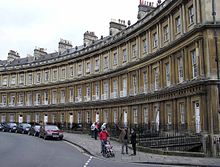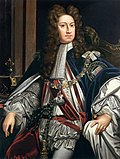Georgian era
| Georgian Era | |||
|---|---|---|---|
| 1714–1830 | |||
 | |||
| Including | British Regency | ||
Chronology
| |||
| Periods in English history |
|---|
| Timeline |
The Georgian era is a period of British history, normally defined as including the reigns of the kings George I, George II, George III and George IV, i.e. covering the period from 1714 to 1830, (with the sub-period of the Regency, defined by the Regency of George IV as Prince of Wales during the illness of his father George III). Sometimes the reign of William IV (1830 to 1837) is also included.
The term "Georgian" is normally used in the contexts of architecture and social history.
The arts
Especially during the mid-18th century, the period was marked by cultural vibrancy, with the establishment of the British Museum in 1753, and the contributions of such famous men as Dr. Samuel Johnson, William Hogarth, Samuel Richardson, and George Frideric Handel, among many others.
Georgian society and its preoccupations were well portrayed in the novels of writers such as Henry Fielding, Mary Shelley and Jane Austen, characterised by the architecture of Robert Adam, John Nash and James Wyatt and the emergence of the Gothic Revival style, which hearkened back to a supposed golden age of building design.
The flowering of the arts was most vividly shown in the emergence of the Romantic poets, principally through Samuel Taylor Coleridge, William Wordsworth, Percy Bysshe Shelley, William Blake, John Keats and Lord Byron. Their work ushered in a new era of poetry, characterized by vivid and colourful language, evocative of elevating ideas and themes.
The paintings of Thomas Gainsborough, Sir Joshua Reynolds and the young J. M. W. Turner and John Constable illustrated the changing world of the Georgian period - as did the work of designers like Capability Brown, the landscape designer.
Social change
It was a time of immense social change in Britain, with the beginning and other parts of the British Empire.
Social reform under politicians such as Robert Peel and campaigners like William Wilberforce, Thomas Clarkson and members of the Clapham Sect began to bring about radical change in areas such as the abolition of slavery, prison reform and social justice. A revival in Christianity was seen in the Church of England with men such as John Wesley (later to found the Methodists) and John Newton, and the rise of Non-conformists such as George Whitefield and various Dissenting groups.
Philanthropists and writers such as Hannah More, Thomas Coram, Robert Raikes and Beilby Porteus, Bishop of London, began to address the social ills of the day, and saw the founding of hospitals, Sunday schools and orphanages.
The loss of the American Colonies and the American Revolution were regarded as national disasters. In Europe, the Napoleonic Wars dragged on for nearly a quarter of a century, bringing statesmen and national heroes like the Duke of Wellington and Admiral Lord Nelson home to huge public acclaim.
The expansion of empire brought fame to statesmen and explorers such as Clive of India and Captain Cook, and sowed the seeds of the world-wide British Empire of the Victorian and Edwardian eras which were to follow.
Fine examples of distinctive Georgian architecture are Bath, Georgian Dublin and Bristol.
Politics and social revolt
With the ending of the War with France, the United Kingdom entered a period of greater economic depression and political uncertainty, characterised by social discontent and unrest. The Radical political party published a leaflet called The Political Register, also known as "The Two Penny Trash" to its rivals. The so-called March of the Blanketeers saw 400 spinners and weavers march from Manchester to London in March 1817 to hand the Government a petition. The Luddites destroyed and damaged machinery in the industrial north-west of England. The Peterloo Massacre in 1819 began as a protest rally which saw 60,000 people gathering to protest about their living standards, but was quelled by military action and saw eleven people killed and 400 wounded. The Cato Street Conspiracy of 1820 sought to blow up the Cabinet and then move on to storm the Tower of London and overthrow the government. This too was thwarted, and the conspirators executed or transported to Australia.
Timeline
- 1714
- Accession of George I.
- 1715
- Whigs win the British General Election.
- 1727
- Accession of George II.
- 1746
- Final Jacobite rising crushed at Battle of Culloden.
- 1760
- Accession of George III.
- 1765
- Stamp Act passed by parliament of Great Britain.
- 1775
- War of Independence begins in the Thirteen Colonies.
- 1783
- British recognition of American independence as Treaty of Paris is signed by David Hartley representing George III.
- 1811
- George IV begins nine-year tenure as prince regent. This sub-period is defined as the Regency period.
- 1815
- Napoleon I of France defeated by the Seventh Coalition at the Battle of Waterloo.
- 1819
- Peterloo Massacre
- 1820
- Death of George III. Accession of George IV.
- 1830
- Death of George IV. End of the Georgian era.

|
File:KING GEORGE II.jpg | 
|

|
| George I | George II | George III | George IV
|
References
- Hochschild, Adam. Bury the Chains, The British Struggle to Abolish Slavery (Basingstoke: Pan Macmillan, 2005)
- Phillips, Charles. The Illustrated Encyclopedia of the Kings and Queens of Britain. London: Hermes House (Arness Publishing), 2006 ISBN 0-681-45961-1
- Napierała, Piotr , Sir Robert Walpole (1676-1745) – twórca brytyjskiej potęgi, Wydawnictwo Naukowe UAM, Poznań 2008, s. 33-38. ISBN 978-83-232189-8-2
Note: In the twentieth century, the period 1910–1936 was informally called the Georgian Era during the reign of George V (following the Edwardian Era), and is sometimes still referred to as such.[1]; see Georgian Poetry.
- ^ American Heritage Dictionary, http://www.bartleby.com/61/83/G0098300.html
See also
